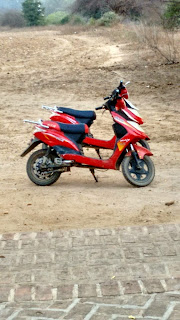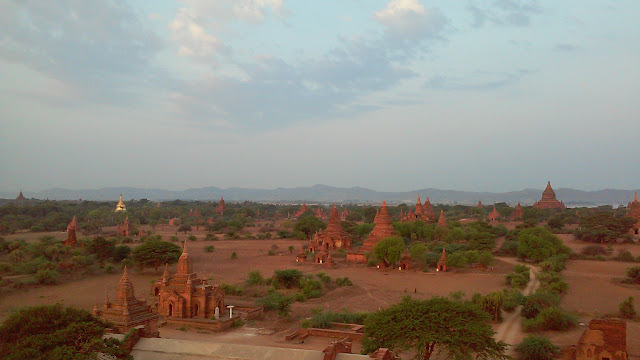Bagan is perhaps Myanmar's most mystical, stunning and photographed site. In a true ditz move, I left my camera battery charging in Yangon, so all I have to offer are a few android cellphone pictures.
This ancient city was established when a great Bamar king converted from Hinduism to Buddism. Over several miles of plains, some 4000 temples dot the landscape. The construction took place over a 230 year period ending in 1287. The majority of signed temples indicate building years of 1150 to 1200. The structures are monuments to the power of Buddhism in this area with an emphasis on mediation but also to the older belief that building a temple for the Buddha might help atone for sins committed in this life and prevent a powerful person from being reincarnated as something undesirable like a woman. (Reincarnation as a woman is lower than many other animals)
Devotion to Buddha and fear of reincarnation made Bagan a majestic panorama of mostly red brick temples with accents of occasional white temples and golden pagodas. One can drive for 20 minutes along the main road and there are temples as far as the eye can see. The touristic part is split into Old and New Bagan. Old Bagan is an area of hotels and businesses nestled within the highest concentration of impressive temples, near the original ancient Bagan City center. In 1990 the Myanmar government ordered a relocation of all people living within the old city limits and through imminent domain (aka the military junta government says do it) relocated them to some former peanut fields a few miles away. We stayed in new Bagan at the lovely Arthawka Hotel. Like most tourists, we saw Bagan riding around on electric bikes. The e-bikes were more like scooters, and made me feel like I was touring this ancient city either on very fast motorized wheel chair or a very slow podracer from Star Wars Episode One: Phantom Menace. So while feeling like a very lucky medicare recipient vs. a star wars character, I whirred along the red dirt paths from temple to temple.
 |
| Buddha in a small shrine |
 |
| Our e-bikes |
Each temple, from those the size of a doll's house to grander mansion sized temples have at least one Buddha statue within the sanctuary. Many of the midsized temples have a tiny staircase to un upper level mediation area that also opens onto the roof of the temple. From the roof of any of these temples, we had a splendid view of the whole plain. On our first evening in Bagan, we set out on our e-bikes to watch the sunset. We met a young artist from Bagan who showed us which temples we could climb on and pointed out the major temples on the plains.
We spent one and a half days in Bagan and could have used one more to properly see all of the major temples. It the hottest time of the year to visit Bagan. As these temples are Buddhist holy sites and many are actively worshipped, we have to remove our shoes to enter even the courtyard of the temple. By 10am the blazing sun heats the stones to a scorching temperature and it is painful to walk on any unshaded part. We woke up at 4:30am and were on our e-bikes by 5am, speeding down the main road from new to old Bagan. We made a disorganized tour of the major temples, with a few instances of driving our tiny machines through thick sand trying to get from one track to another. A few of the temples have decently preserved frescoes of the Buddha's life and teachings. The whole setting of holy places in such a desolate place reminded me of the cave churches in Kappadokya. The battery of Sam's e-bike started to drain quickly around 8am, so we started our journey back to the hotel.
We went went out again in the evening to catch sunset from a temple rooftop, but a threatened rainstorm chased us and our dinky e-bikes back to New Bagan. Instead we watched the sun set along the Ayeyarwady River and had a delicious meal of mutton curry, coconut rice, lentils, and eggplant.
 |
| Sunset over the Ayeyarwady River |
 |
| Standing Buddha inside Ananda Pahto |
 |
| Hallway of Ananda Pahto |








No comments:
Post a Comment